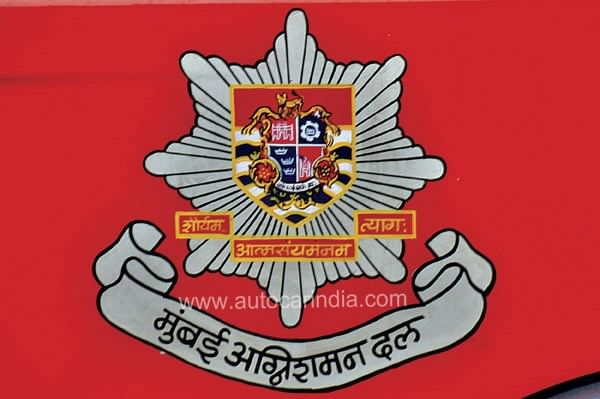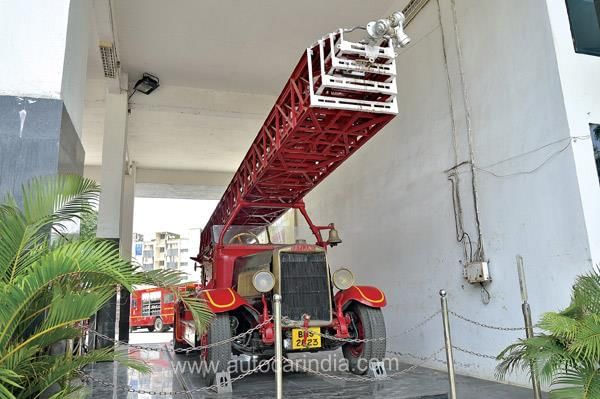This vehicle comes with its own soundtrack. People of a certain vintage will remember it as the strident metallic notes of a brass bell which has now been replaced with an electronic siren. The fire truck carries not just the firemen and their equipment, but hope, succour, and relief. As American author, Kurt Vonnegut rightfully said, “I can think of no more stirring symbol of man’s humanity to man than a fire engine”.
We have often seen this red giant truck making its way through traffic. But what really goes on in this vehicle? What happens when you dial 101? We went down to the Mumbai Fire Brigade’s HQ at Byculla to know more.
When a call comes, firemen have 60 seconds to scramble to the truck and be on their way. 60 seconds from the first call to the truck leaving the fire station. The men and the vehicles are always on alert and have to be prepared to move at a moment’s notice. Every fire truck is manned by a team of seven. A Fire Officer heads the team along with a Leading Fireman under whom are four firemen. The driver of the truck also doubles up as the operator for the various equipment in the truck. Do note that ‘fireman’ here refers to both men and women since the first female firefighters were inducted into the Mumbai Fire Brigade in 2012. Today, there are 16 female firefighters in the brigade at posts ranging from Firemen to Assistant Station Officer.

The Mumbai Fire Brigade, one of the finest in the country, has shown its métier time and again. During the 2008 Mumbai attacks, they faced the bullets of militants to tackle fire and rescue hotel guests. The equipment they had was old and obsolete. Even the distinctive uniform they were wearing harked back to that of the London Fire Brigade from the 1950s and offered limited protection. The Mumbai Fire Brigade is modelled after the London Fire Brigade and that’s why Mumbai firemen are the only ones in the country to wear blue, rather than the khaki adopted by most other firefighters across the country. In 2010, the city’s firefighters were given head-to-toe suits that met international standards, helmets with protective visors, in-built radios, breathing apparatus and neck shields. The plumed helmets, rubber gumboots, leather belts and brass buckles were finally consigned to history.
After years of plodding along with old and obsolete equipment, the force now boasts some of the latest and most advanced equipment in its fleet. But the biggest push towards modernisation began earlier this year, with the Mumbai Fire Brigade investing in critical new equipment and vehicles.
What is commonly called a fire engine is the first-call or first response vehicle that is dispatched after a call is received by the control room. In firemen’s lingo it is called a Motor Pump. This is a truck that is present at every fire station in Mumbai, and one that is used for all types of calls, from fire to building collapse to bird rescue. While earlier, the backbone of the fleet came from Tata, this year it was made stronger with the introduction of 16 MAN trucks.
The MAN CLA 16.300 is powered by a 6.9-litre, six-cylinder, in-line, direct-injection diesel engine with a turbocharger and intercooler. The engine produces 300hp at 2,000rpm, and a maximum torque of 1,150Nm between 1,200-1,800rpm. Power is transferred through a six-speed automatic Allison gearbox. Think of it as a fire truck of all trades. It carries 4,500 litres of water apart from a variety of equipment like a ladder, hoses, hose fittings, hand tools, hydraulic rescue tools (cutter, spreader, ram and power pump pack), pneumatic lifting bags, thermal sensing camera, and breathing apparatus with four suit sets.
In case of a bigger fire, a Jumbo Tanker or Water Tanker is called in. The Jumbo Tanker can carry anywhere between 14,000 to 18,000 litres of water, and the ones in service with the fire brigade are made by Mercedes-Benz and MAN. The Water Tanker is a smaller Tata truck with 9,000-litre capacity.

Another specialised vehicle that’s part of the Mumbai Fire Brigade’s fleet is a Rescue Van built on a MAN TGM 18.330 4X4 chassis. The 330hp engine is mated to a ZF AMT transmission. The seven lockers in the truck carry more than 200 pieces of specialised equipment.
Mumbai is growing, and growing vertically. The city’s skyline is dotted with high-rise buildings and skyscrapers. As the megapolis grows so does the need to be able to reach the higher floors. For this, the brigade has a fleet of Ladder Trucks. The big daddy of them all is a 16.5-metre long, 4.15-metre high and 2.55-metre wide behemoth that weighs over 50 tonnes. The vehicle is a Mercedes-Benz Actros 6260 equipped with a 90-metre hydraulic platform made by Finland- based company, Bronto Skylift. This is the first 90-metre fire ladder in India to be pressed into a government fire-fighting and rescue organisation.
This Mercedes is powered by a 600hp OM-series V8 engine along with Telligent automated manual transmission. The truck has six-axles of which the first, second, third and sixth axles are steerable, while the fourth and fifth axles are powered. Known as a hydraulic platform, this special-application vehicle can reach a height of 30 floors of a high-rise. A built-in, fire-fighting pump on the vehicle is driven by a Power Take-Off (PTO) shaft from the engine, and has a maximum capacity of 6,000 litres per minute at 10 bar pressure. In case the PTO fails, the ladder can be operated by a small stand-by diesel-engine- driven pump. If both the engine and pump fail, the ladder can be operated using the vehicle’s battery. And you thought it was only modern airliners that had redundancies built into their systems!
This vehicle has four computers which interact with each other through a CAN bus system, and the height, angle and every movement is programmed. The vehicle has two controls – one is the turntable control, and the other is the cage control; the platform that can carry a load of up to 500kg.
The other specialised vehicle you might see at the site of a major fire is a Breathing Apparatus Vehicle. Casualties in the team are rarely caused by fires; most die of suffocation. So when a fireman enters a burning building, he carries with him cylinders of breathable air on his back. Each self-contained cylinder lasts about 45 minutes. This is where the Breathing Apparatus Vehicle comes into play. The vehicle is equipped with an air compressor that can fill up a depleted cylinder in five minutes, thus allowing the firemen to do their job without any interruptions.

When you see these brave firefighters in their red trucks, it’s hard not to think that their job is a matter of life and death. You are right, but it isn’t always the case. On December 2, 2013, the fire brigade received a call from Masjid Bunder to rescue a crow entangled in a kite thread. It was just another routine call for the firemen who are often called in to rescue trapped birds and animals, clear fallen trees and oil spills. A 31-year-old fireman, Umesh Parvate, climbed up the roof of a godown to reach the bird, but the roof gave way and he fell, hitting his head on an iron beam. Parvate died in hospital a few days later. In a testimony to the commitment of the firemen of Mumbai Fire Brigade, Parvate’s colleagues scaled the roof and saved the crow, as Parvate was rushed to hospital. This brings us to a burning question. The Mumbai Fire Brigade receives about 10,000 bird rescue calls every year. That’s about 27 calls everyday! This doesn’t include clearing fallen trees and oil spills. Can we afford to continue stretching this force?
One of the most important parts of any emergency response team is readiness. All the vehicles have to be kept ready and prepared to move at a moment’s notice. The truck has to start at the first twist of the ignition. The pumps have to work when you switch them on. There’s no room for excuses when lives are at stake. Therefore, the Mumbai Fire Brigade runs its own repair and maintenance workshop, manned by highly trained engineers and technicians.
Today, the Mumbai Fire Brigade may have the best equipment and the firefighters may have trained hard until jumping into danger is a reflex action, but they are still defeated by one thing – public apathy. Next time you hear the siren wailing and see the red truck approaching, salute them if you want but more importantly, give way. You might miss an important appointment, but you could do your part in saving a few lives.
History
The history of the Mumbai Fire Brigade can be traced back to 1887, 1855 or 1777 – depending on how you look at it. The need for organised protection against fires was recognised in 1777 and a group was formed. In 1855, the Bombay Fire Brigade came into being as a part-time police function, and a regular fire service with horse-drawn fire engines was set in motion under the control of the Commissioner of Police. Bombay was growing by leaps and bounds, and with it came the need for better fire services. On April 1, 1887, the Bombay Fire Brigade became the responsibility of the Municipality and that’s the way it stands even today.
The Flag

The Mumbai Fire Brigade is the only brigade to have its own flag. A separate emblem for the brigade was approved and adopted in 1975, and the colours presented at the hands of the Governor of Maharashtra in 1980. The star is the symbol of the fire service, and is also a part of the emblem of the London Fire Brigade. Being the parent organisation of the Mumbai Fire Brigade, at the centre of the emblem is the Coat of Arms of the Municipal Corporation of Greater Bombay. At the base of the emblem are three words: Shouryam (Valour), Atmasanyamanam (Abnegation) and Tyagah (Sacrifice) – the three objectives which the brigade and its personnel are always exhorted to uphold and carry on.
Retired warrior

The firetruck of today is a far cry from the first firetrucks that went into disaster zones. When you walk into the Byculla Fire Station, one of the first things that you see is a vintage Leyland Fire Truck, that has recently been restored to near perfect condition. Manufactured in 1936, it was procured by Bombay Fire Brigade in 1937. Powered by a six-cylinder Rolls-Royce petrol engine, the 9.5-metre long and 2.5- metre wide wooden body truck weighs 19.5 tonnes. It carries a ladder, made in Germany, that can stretch to 37 metres. This truck was part of the rescue efforts at the time of the devastating Bombay Docks Explosion in 1944, when the freighter SS Fort Stikine caught fire and exploded killing over a 1,000 people and destroying several ships. Over 60 firemen lost their lives in the tragedy, and a memorial at the fire brigade headquarters stands as a reminder of their sacrifice. It is in memory of the incident that April 14 is observed as National Fire Service Day.
Joy Chaudhuri, with inputs from Akbar Merchant





































